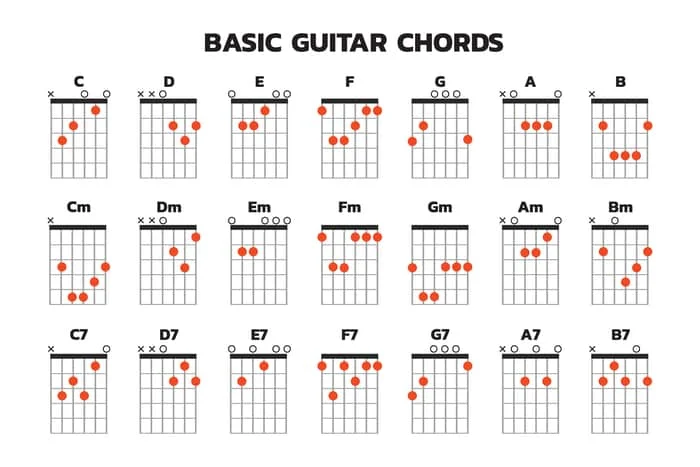How to play guitar chords(All You Need To Know)

How to play guitar chords – Learning to play guitar chords is a thrilling adventure that opens up a world of musical possibilities. Understanding and mastering guitar chords is vital for performing songs and creating your own music, whether you’re a beginner or have some experience. We’ll walk you through the fundamentals of playing guitar chords, from finger positioning to typical chord shapes, in this post. So grab your guitar and join me as we explore the world of guitar chords! EnoughInfo.com

A Beginner’s Guide to Playing Guitar Chords
Section 1: Recognising Guitar Chords
What exactly are guitar chords?
Guitar chords are harmonies created by playing multiple notes at the same time. They’re made by putting your fingers on specific frets and strings on the guitar neck.
Chords are represented in what way?
Chord diagrams, which are visual representations of the guitar neck, are used to illustrate chords. They depict the strings, frets, and finger placements needed to play a particular chord.
Section 2: Learning to Play Basic Guitar Chords
1, Finger positioning and technique
Put your fingers on the strings and frets indicated in the chord diagram. To guarantee a clear tone, press down firmly on the strings with the tips of your fingers. Avoid accidentally touching adjacent strings or muting any strings. How To Stop Masturbation (All You Need To Know)
2, Open chords that are commonly used by beginners
a. E major: Put your first finger on the third string of the first fret, your second on the fifth string of the second fret, and your third finger on the fourth string of the second fret. From the sixth string down, strum.
b. A major: Place your first and second fingers on the fourth string of the second fret, your third finger on the third string of the second fret, and your fourth finger on the second string of the second fret. Strumming from the fifth string down.
c. D major: Place your first and second fingers on the third string of the second fret, your first and second fingers on the first string of the second fret, and your third finger on the second string of the third fret. From the fourth string down, strum.
Section 3: Practise Suggestions and Common Obstacles
a. Begin with calm and precise strumming: Strumming each chord individually ensures that each note sounds clear. Gradually increase your speed as you gain confidence.
b. Chord transitions: Practice gracefully shifting between chords. Begin by practicing two-chord changes and work your way up to increasingly difficult progressions. Maintain a consistent rhythm by using a metronome or backup track.
c. Be gentle with your finger strength and dexterity: Pressing down on the strings may feel difficult at first. As you practice, your fingers will strengthen and chord changes will become easier.
Section 4: Frequently Asked Questions and Answers
1, How long does it take to learn how to play the guitar chords?
Learning guitar chords take different amounts of time for different people. With constant practice, you may learn to play basic chords in a matter of weeks. Chord transition mastery and fluency will come with practice. How to lose weight without exercise(The Ultimate Guide)
2, Should I strum chords with a guitar pick or my fingers?
It’s a matter of personal taste. Using a pick produces a brighter, more defined sound, whilst strumming with your fingers produces a warmer, more mellow tone. Experiment with both methods to see which one works best for you.
3, How can I make my chord transitions better?
Practicing chord transitions is essential for improving them. Begin by identifying the difficult chord change and practicing it again. Slow down the tempo and gradually increase the speed as you become used to it. Keep your fingers near the strings and avoid needless motions.
4, Are there alternate chord fingerings?
There are frequently several methods to finger a chord. Examine various fingerings to discover the one that feels the most natural and allows for smooth transitions between chords. Some different fingerings may be simpler for some people due to hand size and flexibility.
5, How can I tell if I’m doing the chords correctly?
Pay close attention to the note clarity. Strumming each string separately ensures that all notes ring clearly without any muffled or buzzing noises. Adjust your finger placement and apply enough pressure to press the string against the fret if a string isn’t sounding right.
6, Are there any workouts I can do to improve my chord-playing abilities?
There are various activities you may do to improve your chord-playing abilities. One practice includes switching back and forth between two chords, progressively increasing the tempo. Strumming a chord and then picking each string individually ensures that all the notes sound clear. These exercises will help you strengthen your fingers and enhance the accuracy of your chords.
Conclusion:
Learning to play guitar chords is a necessary step toward becoming a competent musician. You’ll gradually gain the skills required to play a wide range of songs by grasping the fundamentals of finger positioning, practicing chord transitions, and overcoming typical problems. Remember to be patient, and consistent, and to have fun with the process. With practice and devotion, you’ll soon be strumming and playing your favorite songs on the guitar with confidence. So keep practicing, enjoy making music, and let your guitar chords serve as the cornerstone of your musical adventure!
Recommended;
30 Hobbies That Make You Money
11 Ways To Gain Healthy Weight Fast Naturally(2023 Guide)
22 Top Foods For Promoting Heart Health(All You Need to Know)
